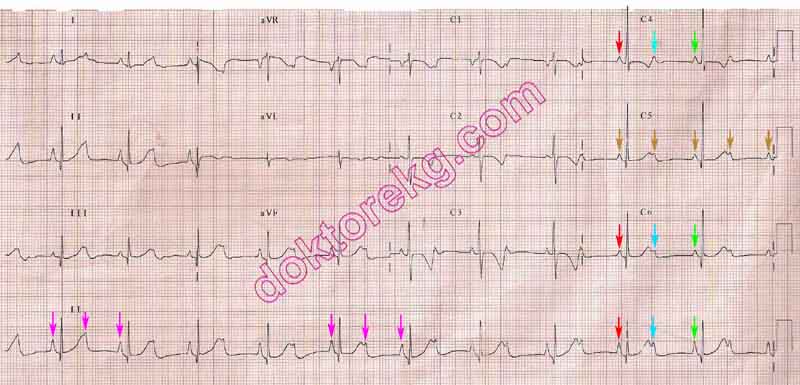d o t o r e
t o r e g . c o m
g . c o m
Dr. Mete ALPASLAN
Ventriculophasic Sinus Arrhythmia - VPSA
Definition
 Phasic change of the sinus rate in relation to the QRS complex.
Phasic change of the sinus rate in relation to the QRS complex.
 The PP interval containing the QRS complex is shorter than the PP interval not encompassing it.
The PP interval containing the QRS complex is shorter than the PP interval not encompassing it.
Where do we see it?
 In some patients with high degree AV block or complete AV block.
In some patients with high degree AV block or complete AV block.
 In some patients with ventricularly paced rhythms.
In some patients with ventricularly paced rhythms.
Mechanism
 Exact mechanism is unknown. Suggested mechanisms are:
Exact mechanism is unknown. Suggested mechanisms are:
- Ventricular contraction following the QRS complex increases blood flow to baroreceptors which in turn affects sinus rate through vagal stimulation.
- Ventricular contraction following the QRS complex increases blood flow to sinus node which in turn increases sinus rate.
Paradoxical Ventriculophasic Sinus Arrhythmia
 The PP interval containing the QRS complex is longer than the PP interval not encompassing it.
The PP interval containing the QRS complex is longer than the PP interval not encompassing it.
 Paradoxical ventriculophasic sinus arrhythmia is very rare.
Paradoxical ventriculophasic sinus arrhythmia is very rare.
 Mechanism is unknown.
Mechanism is unknown.
References
 Circulation 1998;97:2245-2251.
Circulation 1998;97:2245-2251.
 Cardiology 1970;55:65-8.
Cardiology 1970;55:65-8.
 Circulation 1955;11:240-61.
Circulation 1955;11:240-61.
 Journal of Cardiology Cases 2011;3:e37-e39.
Journal of Cardiology Cases 2011;3:e37-e39.
 Int J Cardiol 2003;91:71-74.
Int J Cardiol 2003;91:71-74.

ECG 1. The ECG above is from a 6 months-old infant with non-restrictive type VSD. He has congenital 2:1 AV block.
Of every two P waves, only one can be conducted to the ventricles . Also, the interval between the first P wave and
the second P wave is shorter than the interval between the second P wave and the third P wave .
This is called as VENTRICULOPHASIC SINUS ARRHYTHMIA . It is less pronounced on the left side of this ECG .
Pediatric cardiologist Dr. Mahmut Gokdemir has donated this ECG to our website.
Click here for a more detailed ECG

ECG 2. Wenkebach type 2:1 AV block. Narrow QRS complexes suggest Mobitz Type 1, 2:1 AV block.
Of every two P waves only one is conducted to the ventricles while the other is not .
The above ECG was recorded at a calibration of 20 mm/mV to show the P waves more clearly.
Click here for a more detailed ECG

ECG 3. The above ECG is from a 67 years-old man and shows ventricular trigeminal rhythm with interpolated VPCs.
The PP interval containing the VPC is shorter than the PP interval not encompassing it.
Also, the first PR interval following the VPC is relatively prolonged when compared with the preceding PR interval.
Click here for a more detailed ECG
 Phasic change of the sinus rate in relation to the QRS complex.
Phasic change of the sinus rate in relation to the QRS complex.
 The PP interval containing the QRS complex is shorter than the PP interval not encompassing it.
The PP interval containing the QRS complex is shorter than the PP interval not encompassing it.
Where do we see it?
 In some patients with high degree AV block or complete AV block.
In some patients with high degree AV block or complete AV block.
 In some patients with ventricularly paced rhythms.
In some patients with ventricularly paced rhythms.
Mechanism
 Exact mechanism is unknown. Suggested mechanisms are:
Exact mechanism is unknown. Suggested mechanisms are:
- Ventricular contraction following the QRS complex increases blood flow to baroreceptors which in turn affects sinus rate through vagal stimulation.
- Ventricular contraction following the QRS complex increases blood flow to sinus node which in turn increases sinus rate.
Paradoxical Ventriculophasic Sinus Arrhythmia
 The PP interval containing the QRS complex is longer than the PP interval not encompassing it.
The PP interval containing the QRS complex is longer than the PP interval not encompassing it.
 Paradoxical ventriculophasic sinus arrhythmia is very rare.
Paradoxical ventriculophasic sinus arrhythmia is very rare.
 Mechanism is unknown.
Mechanism is unknown.
References
 Circulation 1998;97:2245-2251.
Circulation 1998;97:2245-2251.
 Cardiology 1970;55:65-8.
Cardiology 1970;55:65-8.
 Circulation 1955;11:240-61.
Circulation 1955;11:240-61.
 Journal of Cardiology Cases 2011;3:e37-e39.
Journal of Cardiology Cases 2011;3:e37-e39.
 Int J Cardiol 2003;91:71-74.
Int J Cardiol 2003;91:71-74.

ECG 1. The ECG above is from a 6 months-old infant with non-restrictive type VSD. He has congenital 2:1 AV block.
Of every two P waves, only one can be conducted to the ventricles . Also, the interval between the first P wave and
the second P wave is shorter than the interval between the second P wave and the third P wave .
This is called as VENTRICULOPHASIC SINUS ARRHYTHMIA . It is less pronounced on the left side of this ECG .
Pediatric cardiologist Dr. Mahmut Gokdemir has donated this ECG to our website.
Click here for a more detailed ECG

ECG 2. Wenkebach type 2:1 AV block. Narrow QRS complexes suggest Mobitz Type 1, 2:1 AV block.
Of every two P waves only one is conducted to the ventricles while the other is not .
The above ECG was recorded at a calibration of 20 mm/mV to show the P waves more clearly.
Click here for a more detailed ECG

ECG 3. The above ECG is from a 67 years-old man and shows ventricular trigeminal rhythm with interpolated VPCs.
The PP interval containing the VPC is shorter than the PP interval not encompassing it.
Also, the first PR interval following the VPC is relatively prolonged when compared with the preceding PR interval.
Click here for a more detailed ECG